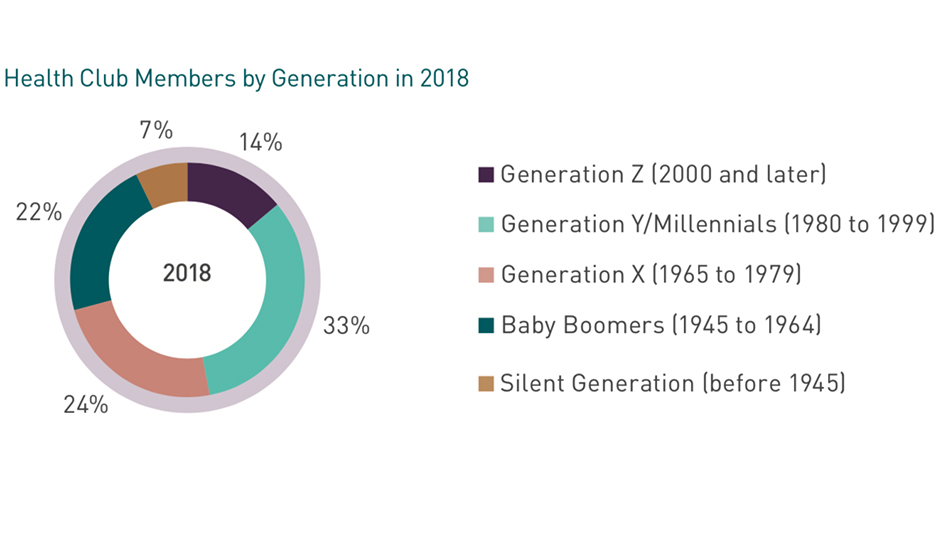In addition to a deep dive into a generation’s impact on the industry, a city in Virginia is named America’s Fittest City; we release the 2019 IHRSA Health Club Consumer Report (which shows membership growth and the makeup of health club consumers); a Brooklyn woman puts community first when opening a Pilates studio; World Wellness Weekend took place in late September; and so much more!
Fitness Industry Roundup: Millennials Are Good for Business
The “experience” generation is set to give the fitness industry a boost, as long as business is willing to keep up. Is a new NYC boxing studio up to the task?
Ignore the headlines sounding the alarm on the death of several industries because of Millennials. Research by CB Insights shows that although the generation may have different tastes, they will actually help boost business, as long as the business serves their wants and needs. And the fitness industry is more than ready to reap the benefits as the “experience” generation ages into their peak spending years and grabs hold of economic power. The generation already puts an emphasis on fitness, according to research, with over 76% of Millennials saying they exercise at least once a week, compared to 70% of Generation X and 64% of Baby Boomers. Their wallets also point a willingness to spend on the industry, with over over $7 billion spent annually on health club memberships. But all that cash isn’t going to big box gyms, an industry segment that is seeing stagnate numbers. Instead, the growth has been at the ends of the spectrum: budget gyms and boutique studios. IHRSA research backs up that finding as budget gyms like Planet Fitness and boutiques such as SoulCycle have grown exponentially within the last few years, both buoyed by the age group. Because of this trend, some traditional gyms are developing different programs to attract the coveted cohort.
Learn which other industries will thrive thanks to Millennials.
Boutique Brings in Booze & Bitcoin
Grit Bxng isn’t just another boxing studio, at least that’s what founder Bill Zanker hopes. In a Fast Company article, Zanker explains how incorporating a full liquor bar, bitcoin, and competitive pay for personal trainers will be a differentiator in the crowded boutique field. Grit Bxng, which is located in New York City, offers an instructor-led circuit of boxing, cardio, and strength training in a room that touts $1 million in equipment. The boutique also accepts bitcoin as payment, becoming the first gym to do so. But one of the main selling points for an exerciser is the bar. “That’s what we wanted to do is build a community,” Zanker said. “Right after class, you can hang out, meet somebody, talk to somebody, have a drink with them, and just hang.” But for a potential trainer, the pay is enough to attract the best. Zanker will pay trainers up to $1,000 an hour, because “no matter what, if you don’t have the greatest instructor in front of the room to motivate you, then it doesn’t do anything,” he said. “These guys are rock stars, and rock stars get paid.”
Learn about the Grit Bxng experience.
This Virginia City Takes the Top Spot for Fitness
Arlington, VA, was named “America’s Fittest City” for 2019 by the American College of Sports Medicine earlier this year, the organization announced. The rankings, revealed in the annual American Fitness Index, were determined by evaluating 100 of the largest cities in the states and comparing 33 different health indicators. Some of those indicators include health behaviors, rates of chronic diseases, and community infrastructure. Arlington swept the competition by placing within the Top 10 for 22 health behavior indicators, and took the No. 1 spot in the following categories: percentage of residents exercising in the last month (92%); meeting aerobic and strength activity guidelines (32.9%); reporting good or excellent health; and having low rates of smoking, poor physical health, and pedestrian fatalities. To compare, only 75% of residents in the 100 largest cities said they’d exercised in the last month, and only 22% met the aerobic and strength activities guidelines. The top 10 include Seattle, WA; Minneapolis, MN; San Francisco, CA; Madison, WI; Washington, D.C.; St. Paul, MN; Irvine, CA; Denver, CO; and Portland, OR.
Learn about the rankings and other fitness news in the August issue of CBI.
Serving an Underserved Community
Being told by a photographer that she’s never seen a black woman do Pilates before was the spark Ife Obi, a former marketing strategy director in Manhattan, needed to change just that. In an article by Refinery29, Obi shares her journey on starting a Pilates studio in an underserved neighborhood with no real business plan. “You never know what’s going to happen,” she said. “When you open a place—especially when there’s no historical data on how it will do in the neighborhood—you don’t know if people will even come or not.” Obi founded The Fit In with community in mind. And the community answered by filling up classes, prompting the opening of a second location. “I knew there had to be more women like me, who wanted something other than yoga, who wanted access to fitness close to home,” Obi said. “It took off. And people were able to see other people who looked like them, right in their neighborhood, not just working out but actually teaching the classes, too. So they could feel as though the people teaching actually understand what they’re going through, because they’ve been through it. It’s just a feeling; it’s like, She gets me, and so I’m comfortable in this space.”
Read the about the launch of The Fit In.
IHRSA Releases New Report

Source: 2019 IHRSA Health Club Consumer Report
The 2019 IHRSA Health Club Consumer Report has been released. The report takes a deep dive into overall U.S. health club trends; membership behavior, attendance, and tenure; an analysis of fees paid overall per club segment; demographics including gender, household income, age, education level, and ethnicity; and more. The report found that Millennials & Gen Xers account for the greatest share of health club membership at a combined 57% of total members, while Generation Z represents 14% of total members, Baby Boomers 22%, and the Silent Generation 7%. You can find the full report, among other IHRSA resources, by logging into your IHRSA account. This publication is available in PDF format for $99.95 (IHRSA member price) and $199.95 (non-members).
Take a peek into the new report.
Collaboration Brings Fitness World Together
This year, IHRSA joined forces with World Wellness Weekend to promote their third annual event, which took place September 21-22. World Wellness Weekend was celebrated by 2,356 venues in 98 countries. Compared to 150 participants in 2017 and 656 in 2018, this represents an annual growth of around 400%. On World Wellness Weekend, spas, fitness centers, salons, yoga studios, and sports organizations opened their doors to the community, offering fun, free wellness activities.
World Wellness Weekend was covered in over 300 publications (press, web, TV, radio), reaching over 136 million people worldwide. IHRSA clubs around the world took part in the weekend, with offerings that included free club access, complimentary group fitness programming, workshops, fitness events, and health screenings.
Read more about IHRSA's participation in the campaign.
IHRSA Pushes for Inclusivity Worldwide
IHRSA's International Public Policy Advisor, Kilian Fisher, spoke on the Best Practices & Good Examples: Health and Education panel during the first InSport - Sport Inclusion: Full Participation in Sport by Persons with Disabilities multiplier event on September 25, 2019. The panel focused on how the health and education sectors could use sports at regional, national, and international levels. This panel was an opportunity to discuss UFIT and the incredible work the fitness industry, IHRSA, and the UNESCO Chair are doing to promote inclusive sport and fitness. The InSport project promotes the full participation and social inclusion of people with disabilities in and through sports, physical activity, and healthy living habits. The event focused on developing a European model for inclusion and discussing strategies to increase opportunities for participation of people with disabilities in the fitness industry. Participation in this event was an opportunity for increased collaboration in Europe and internationally, and shows IHRSA's support of this critical European Commission Project.
Learn about the event’s hosts Cerebral Palsy Association of Almada Seixal (APCAS) and the Portuguese Institute of Sport and Youth.

Rachel Valerio previously served as IHRSA's Digital Content Editor—a position focused on collecting and reporting on fitness industry news, staying on top of IHRSA's social media accounts and website, and hatching new plans to expand the association's digital footprint.